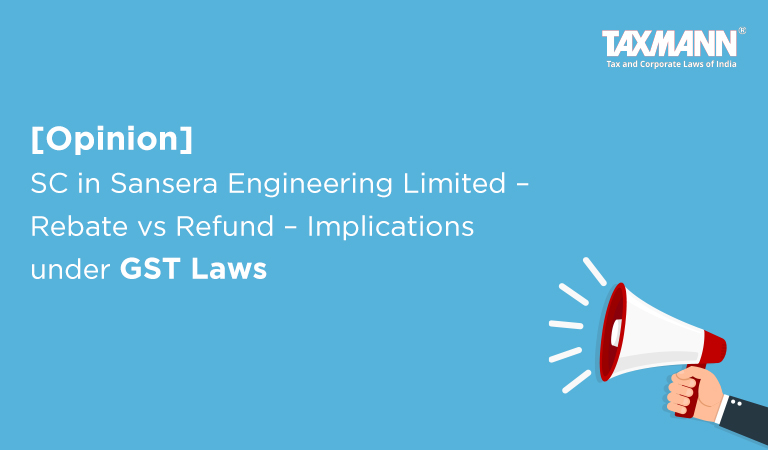[Opinion] SC in Sansera Engineering Limited – Rebate vs Refund – Implications under GST Laws
- Blog|News|GST & Customs|
- 3 Min Read
- By Taxmann
- |
- Last Updated on 4 January, 2023

CA Sri Harsha – [2023] 146 taxmann.com 1 (Article)
The Supreme Court in the Sansera Engineering Ltd. v. Dy. Commissioner, LTV has concluded the long outstanding issue of distinction between the refund and rebate under the erstwhile indirect taxation laws. The assessee tried to distinguish rebate from refund, since there was no specific time limit mentioned for rebate. Before dealing with the said judgment and its implications under the GST laws, a brief background on the thin line of distinction between refund and rebate is sina qua non.
Refund vs. Rebate – Erstwhile Indirect Taxation Laws
Under the system of erstwhile indirect taxation laws, that is under service tax law and excise law, there were majorly two different ways to liquidate the input tax credit, which is used for exports. As everyone is aware, that input tax credit is only given as refund, when the assessee is engaged in export of goods or services. The most regular way is called ‘refund’. In this method, the assessee exports the goods or services, as the case may be, then goes to the tax authorities qua a refund application and seeks the refund of input taxes that have gone into the export of goods or services. Since the exports are zero rated, there will not be any liability for the services and the input tax credit remains unutilised. Naturally, since no country does not want to export taxes, the input tax burden is relieved to the assessee by granting the refund of such input taxes, which have gone into provision of export of goods or services, as the case may be. This ensures that the exporter is essentially exporting the value of goods or services (without loading any input taxes in his sale price) so that he stays competitive in international field. Since such taxes are not loaded into the sale price, the country as an export measure, grants the refund of taxes to the exporter. Such obtaining of input tax credit back from the tax authorities is usually called as refund (though there are other scenarios, where refund is possible, we are restricting here to the extent of export transactions).
In case of rebate, there are other aspects at play. It is not simple as refund, explained above. In case of rebate, the exporter first arrives at the quantum of input tax credit that was used for export of goods or services. Then, based on the quantum, he arrives at the turnover of the goods or services. Let us take an example for better understanding. An exporter has input tax credit of Rs 1 Crore, which is used for export of goods. Then, he arrives at a transaction value, which yields a tax liability of Rs 1 Crore. Naturally, this should be an export transaction. Now, the artificial tax liability (since it is an export transaction, ideally, there should not be any tax liability. However, for the purposes of claiming the rebate, he creates a liability and hence we call it is an artificial tax liability) of Rs 1 Crore is paid using the input tax credit that is lying with him. After such process, he applies to the department, to rebate the taxes paid on such transaction. This is an indirect way or another way to liquidate the input tax credit.
In both the methods, essentially what is being liquidated is the input tax credit, that is used for export of goods or services, as the case may be. Only the modus operandi and terminology is different and nothing else. With this brief background and distinction between the refund and rebate, let us proceed to understand the issue before the Honourable Supreme Court in Sansera Engineering Limited (supra).
Click Here To Read The Full Article
Disclaimer: The content/information published on the website is only for general information of the user and shall not be construed as legal advice. While the Taxmann has exercised reasonable efforts to ensure the veracity of information/content published, Taxmann shall be under no liability in any manner whatsoever for incorrect information, if any.

Taxmann Publications has a dedicated in-house Research & Editorial Team. This team consists of a team of Chartered Accountants, Company Secretaries, and Lawyers. This team works under the guidance and supervision of editor-in-chief Mr Rakesh Bhargava.
The Research and Editorial Team is responsible for developing reliable and accurate content for the readers. The team follows the six-sigma approach to achieve the benchmark of zero error in its publications and research platforms. The team ensures that the following publication guidelines are thoroughly followed while developing the content:
- The statutory material is obtained only from the authorized and reliable sources
- All the latest developments in the judicial and legislative fields are covered
- Prepare the analytical write-ups on current, controversial, and important issues to help the readers to understand the concept and its implications
- Every content published by Taxmann is complete, accurate and lucid
- All evidence-based statements are supported with proper reference to Section, Circular No., Notification No. or citations
- The golden rules of grammar, style and consistency are thoroughly followed
- Font and size that’s easy to read and remain consistent across all imprint and digital publications are applied





